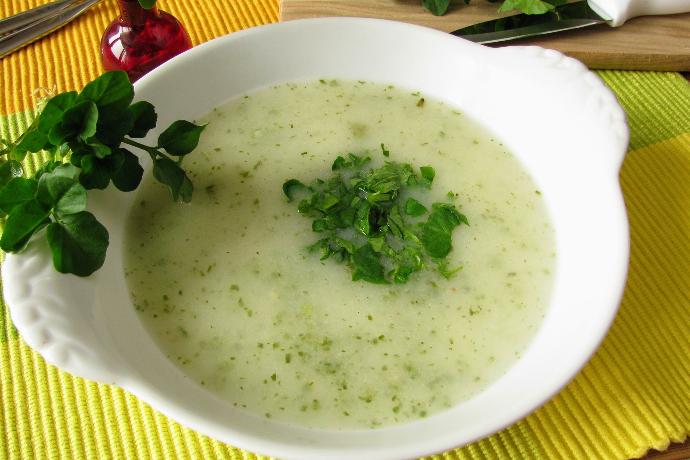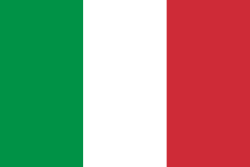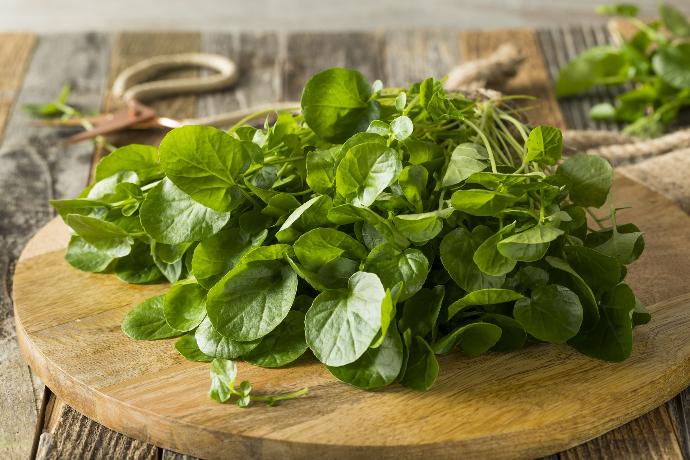Le cresson (Lepidium sativum) est une plante de la famille des crucifères. Il est originaire d'Afrique, du Moyen-Orient et d'Asie. Il y a de nombreuses variétés de cresson, certaines étant cultivées pour leurs feuilles, d'autres pour leurs graines. Le cresson est utilisé depuis l'Antiquité comme plante médicinale et alimentaire.
L'utilisation historique du cresson
Historiquement, le cresson était principalement utilisé pour les vertues médicinales qui lui étaient accordées.
En Égypte, il était utilisé pour traiter les problèmes de digestion et les infections respiratoires. En Grèce antique, il était considéré comme un remède contre l'anémie et les troubles de la thyroïde. Le cresson était également utilisé en médecine ayurvédique en Inde pour traiter les problèmes de digestion et de foie.
Exploration des saveurs
Au fil du temps, le cresson s’est développé dans d'autres régions du monde. Il est particulièrement apprécié pour sa saveur légèrement poivrée et aromatique et est souvent utilisé en cuisine comme assaisonnement. Essayez le en préparant notre soupe de cresson!

Soupe de cresson
Découvrez les bienfaits de cette plante
Le cresson est également une plante très nutritive. Il est riche en vitamines A, K et C, en calcium biodisponible et en minéraux tels que le fer et le phosphore. Il est également une source de potassium. En raison de ses nombreux bienfaits pour la santé, le cresson est souvent conseillé comme légume santé.
Le cresson au potager
Le cresson peut être facilement cultivé en pots ou en pleine terre. C’est une excellente plante à ajouter à un jardin ou à un balcon pour ceux qui cherchent à ajouter une plante nutritive et facile à entretenir à leur espace vert.
L'avantage principal est qu'il peut être cultivé tout au long de l'année, que ce soit en été ou en hiver!
Die Kresse (Lepidium sativum) ist eine Pflanze aus der Familie der Kreuzblütengewächse. Sie ist in Afrika, im Nahen Osten und in Asien beheimatet. Es gibt viele verschiedene Arten von Kresse, von denen einige wegen ihrer Blätter und andere wegen ihrer Samen angebaut werden. Kresse wird seit der Antike als Heil- und Nahrungspflanze verwendet.
Die historische Verwendung von Kresse
Historisch gesehen wurde Kresse hauptsächlich wegen der ihr zugeschriebenen medizinischen Eigenschaften verwendet.
In Ägypten wurde sie zur Behandlung von Verdauungsproblemen und Atemwegsinfektionen eingesetzt. Im antiken Griechenland galt sie als Heilmittel gegen Anämie und Schilddrüsenerkrankungen. Auch in der ayurvedischen Medizin in Indien wurde Kresse zur Behandlung von Verdauungs- und Leberproblemen eingesetzt.
Erforschung der Geschmacksrichtungen
Im Laufe der Zeit hat sich die Kresse auch in anderen Teilen der Welt verbreitet. Sie ist besonders wegen ihres leicht pfeffrigen und aromatischen Geschmacks beliebt und wird in der Küche oft als Würze verwendet. Probieren Sie sie aus, indem Sie unsere Kressesuppe zubereiten!
 Kressesuppe
Kressesuppe
Entdecken Sie die Vorteile dieser Pflanze
Kresse ist auch eine sehr nahrhafte Pflanze. Sie ist reich an den Vitaminen A, K und C, bioverfügbarem Kalzium und Mineralstoffen wie Eisen und Phosphor. Ausserdem ist sie eine Quelle für Kalium. Aufgrund ihrer zahlreichen gesundheitlichen Vorteile wird Kresse häufig als Gesundheitsgemüse empfohlen.
Kresse im Gemüsegarten
Kresse kann leicht in Töpfen oder im Freiland angebaut werden. Sie ist eine hervorragende Pflanze für den Garten oder Balkon für diejenigen, die eine nahrhafte und pflegeleichte Pflanze anbauen möchten.
Der größte Vorteil ist, dass sie das ganze Jahr über angebaut werden kann, egal ob im Sommer oder im Winter!
Watercress (Lepidium sativum) is a plant of the cruciferous family. It is native to Africa, the Middle East and Asia. There are many varieties of watercress, some grown for their leaves, others for their seeds. Cress has been used since ancient times as a medicinal and food plant.
The historical use of watercress
Historically, watercress was mainly used for its supposed medicinal properties.
In Egypt, it was used to treat digestive problems and respiratory infections. In ancient Greece, it was considered a remedy for anemia and thyroid disorders. Watercress was also used in Ayurvedic medicine in India to treat digestion and liver problems.
Exploring the flavors
Over time, watercress has expanded to other parts of the world. It is particularly appreciated for its slightly peppery and aromatic flavor and is often used in cooking as a seasoning. Try it by preparing our watercress soup!
 Watercress Soup
Watercress Soup
Discover the benefits of this plant
Watercress is also a very nutritious plant. It is rich in vitamins A, K and C, bioavailable calcium and minerals such as iron and phosphorus. It is also a source of potassium. Because of its many health benefits, watercress is often recommended as a healthy vegetable.
Watercress in the garden
Watercress can be easily grown in pots or in the ground. It is an excellent plant to add to a garden or balcony for those looking to add a nutritious and easy to maintain plant to their green space.
The main advantage is that it can be grown all year round, whether in summer or winter!
Il crescione (Lepidium sativum) è una pianta della famiglia delle crucifere. È originaria dell'Africa, del Medio Oriente e dell'Asia. Esistono molte varietà di crescione, alcune coltivate per le foglie, altre per i semi. Il crescione è stato utilizzato fin dall'antichità come pianta medicinale e alimentare.
L'uso storico del crescione
Storicamente, il crescione veniva utilizzato soprattutto per le sue proprietà medicinali.
In Egitto veniva utilizzata per trattare problemi digestivi e infezioni respiratorie. Nell'antica Grecia era considerato un rimedio per l'anemia e i disturbi della tiroide. Il crescione è stato utilizzato anche nella medicina ayurvedica in India per trattare problemi di digestione e di fegato.
Esplorare i sapori
Nel corso del tempo, il crescione si è sviluppato in altre parti del mondo. È particolarmente apprezzato per il suo sapore leggermente pepato e aromatico e viene spesso utilizzato in cucina come condimento. Provatelo preparando la nostra zuppa di crescione!
 Zuppa di crescione
Zuppa di crescione
Scoprite i benefici di questa pianta
Il crescione è anche una pianta molto nutriente. È ricco di vitamine A, K e C, calcio biodisponibile e minerali come ferro e fosforo. È anche una fonte di potassio. Grazie ai suoi numerosi benefici per la salute, il crescione è spesso consigliato come verdura salutare.
Crescione in giardino
Il crescione può essere facilmente coltivato in vaso o in piena terra. È una pianta eccellente da aggiungere al giardino o al balcone per coloro che desiderano aggiungere al proprio spazio verde una pianta nutriente e facile da mantenere.
Il vantaggio principale è che può essere coltivata tutto l'anno, sia in estate che in inverno!








Les bienfaits du cresson